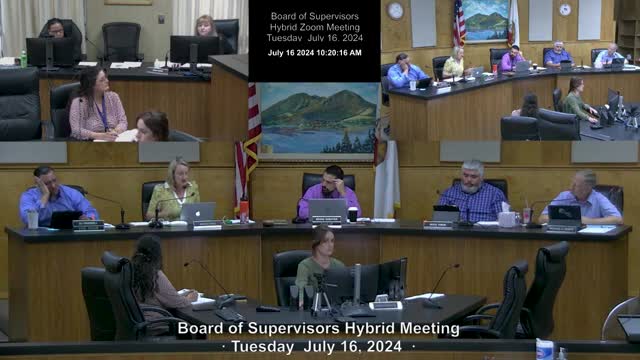Community Advisory Councils Clash Over Planning Process
July 20, 2024 | Lake County, California

This article was created by AI summarizing key points discussed. AI makes mistakes, so for full details and context, please refer to the video of the full meeting. Please report any errors so we can fix them. Report an error »

In a recent government meeting, discussions centered around the composition and functionality of the newly formed BVAC (Bureau of Advisory Councils) and its relationship with existing municipal advisory councils (MACs). Director Turner and other board members emphasized the importance of maximizing community input while navigating the complexities of quorum and Brown Act compliance.
The meeting revealed a contention regarding the appointment of members from the VVAC (Valley View Advisory Council) to the BVAC. One board member proposed allowing three applicants from the VVAC to serve on the BVAC, arguing that their involvement would enhance community representation and input. However, Supervisor Green expressed concerns about the implications of appointing multiple members from the same advisory council, suggesting it could blur the lines between the roles of the BVAC and the MACs, potentially leading to conflicts of interest and procedural complications.
The conversation highlighted the need for clarity on the roles and responsibilities of the BVAC and MACs, particularly regarding their advisory capacities and the process for community engagement. Board members acknowledged the importance of adhering to established deadlines for appointments while ensuring that community voices are heard in the planning process.
County counsel was called upon to provide guidance on the legal implications of the proposed appointments and the potential for Brown Act violations if multiple members from the same MAC attended BVAC meetings. The discussion underscored the necessity for transparency and public participation in the planning process, with assurances that all meetings would be publicly noticed and accessible.
As the board navigates these complexities, the focus remains on fostering effective community engagement while adhering to legal frameworks governing advisory councils. Further discussions are anticipated to refine the process and ensure that the BVAC can effectively serve its intended purpose without infringing on the roles of existing advisory bodies.
The meeting revealed a contention regarding the appointment of members from the VVAC (Valley View Advisory Council) to the BVAC. One board member proposed allowing three applicants from the VVAC to serve on the BVAC, arguing that their involvement would enhance community representation and input. However, Supervisor Green expressed concerns about the implications of appointing multiple members from the same advisory council, suggesting it could blur the lines between the roles of the BVAC and the MACs, potentially leading to conflicts of interest and procedural complications.
The conversation highlighted the need for clarity on the roles and responsibilities of the BVAC and MACs, particularly regarding their advisory capacities and the process for community engagement. Board members acknowledged the importance of adhering to established deadlines for appointments while ensuring that community voices are heard in the planning process.
County counsel was called upon to provide guidance on the legal implications of the proposed appointments and the potential for Brown Act violations if multiple members from the same MAC attended BVAC meetings. The discussion underscored the necessity for transparency and public participation in the planning process, with assurances that all meetings would be publicly noticed and accessible.
As the board navigates these complexities, the focus remains on fostering effective community engagement while adhering to legal frameworks governing advisory councils. Further discussions are anticipated to refine the process and ensure that the BVAC can effectively serve its intended purpose without infringing on the roles of existing advisory bodies.
View full meeting
This article is based on a recent meeting—watch the full video and explore the complete transcript for deeper insights into the discussion.
View full meeting
